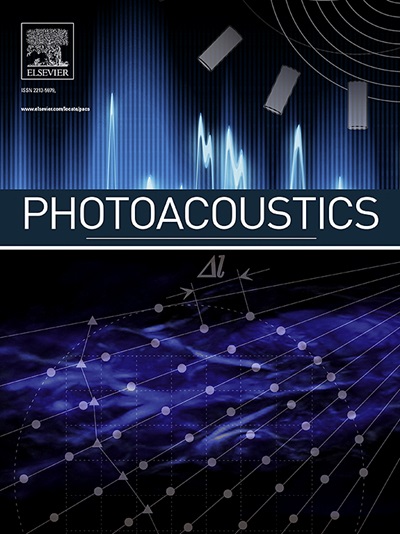Photodissociation-driven photoacoustic spectroscopy with UV-LEDs for ozone detection
IF 7.1
1区 医学
Q1 ENGINEERING, BIOMEDICAL
引用次数: 0
Abstract
This study presents the development and evaluation of a UV-LED based photoacoustic (PA) measurement system for ozone (O3) detection to demonstrate its potential for low-cost and accurate sensing while for the first time addressing the importance of photodissociation for PA signal generation for O3 in the UV range. With a detection limit of 7.9 ppbV, the system exhibits a significant advancement over state-of-the-art UV-PA O3 detection and is on par with laser-based setups. Following a novel discussion of the PA signal arising from photodissociation and its products, cross-sensitivity effects due to environmental factors such as temperature and gas composition were systematically analyzed. A digital twin driven compensation for these influences was implemented and evaluated. Despite the challenges associated with modeling the effects of H2O and CO2, the PA system shows considerable potential, though further studies in real world applications must be conducted.
求助全文
约1分钟内获得全文
求助全文
来源期刊

Photoacoustics
Physics and Astronomy-Atomic and Molecular Physics, and Optics
CiteScore
11.40
自引率
16.50%
发文量
96
审稿时长
53 days
期刊介绍:
The open access Photoacoustics journal (PACS) aims to publish original research and review contributions in the field of photoacoustics-optoacoustics-thermoacoustics. This field utilizes acoustical and ultrasonic phenomena excited by electromagnetic radiation for the detection, visualization, and characterization of various materials and biological tissues, including living organisms.
Recent advancements in laser technologies, ultrasound detection approaches, inverse theory, and fast reconstruction algorithms have greatly supported the rapid progress in this field. The unique contrast provided by molecular absorption in photoacoustic-optoacoustic-thermoacoustic methods has allowed for addressing unmet biological and medical needs such as pre-clinical research, clinical imaging of vasculature, tissue and disease physiology, drug efficacy, surgery guidance, and therapy monitoring.
Applications of this field encompass a wide range of medical imaging and sensing applications, including cancer, vascular diseases, brain neurophysiology, ophthalmology, and diabetes. Moreover, photoacoustics-optoacoustics-thermoacoustics is a multidisciplinary field, with contributions from chemistry and nanotechnology, where novel materials such as biodegradable nanoparticles, organic dyes, targeted agents, theranostic probes, and genetically expressed markers are being actively developed.
These advanced materials have significantly improved the signal-to-noise ratio and tissue contrast in photoacoustic methods.
 求助内容:
求助内容: 应助结果提醒方式:
应助结果提醒方式:


